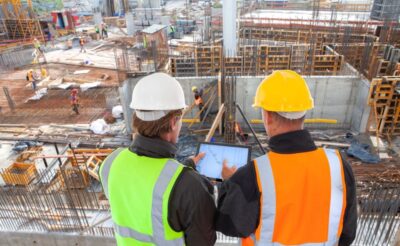If you walk onto a construction site today, you might notice something different. It could be the drone hovering overhead, mapping the progress, or the worker wearing a virtual reality (VR) headset to practice a complex procedure. Maybe it’s the concrete mixer that runs on electricity instead of diesel. Small changes are adding up to something bigger in the construction world.
The industry isn’t known for quick changes, but several forces are nudging it forward. Fewer people specialize in construction jobs, so companies are finding new ways to get work done. Environmental rules are getting stricter. Clients want projects finished faster and with fewer surprises. These pressures create space for fresh ideas that seemed too risky a few years ago.
Here are the trends that are making the biggest impact in 2025:
1. Smart Construction Equipment
Innovative construction equipment is becoming a common sight in today’s construction projects. Machines with sensors, global positioning systems (GPS), and automation features can track real-time progress, handle site grading, and complete repetitive tasks with little supervision.
These capabilities give civil construction contractors more control over operations and help reduce costly mistakes. For large construction projects, where even minor errors can affect schedules and budgets, this added precision makes a significant difference.
Connected technology is also improving how site managers monitor equipment. Instead of waiting for breakdowns, machines can signal when maintenance is needed. This reduces downtime and improves safety standards, giving crews more confidence when working on complex jobs.
The integration of this technology also makes a compelling case for selecting the right civil contractor. A contractor who leverages smart equipment and possesses strong local expertise can best fit the job. For instance, research to find the best Raleigh civil construction company if you’re undertaking a project in the area. This will ensure your team has the knowledge and modern tools to navigate regional regulations, adapt to site conditions, and complete the project efficiently.
2. Green Building and Sustainable Materials
Sustainability has moved to the forefront of civil construction, influencing how projects are planned and delivered. Recycled concrete, energy-efficient systems, and other eco-friendly solutions are becoming common as civil construction contractors work to meet new environmental standards. At the same time, clients prefer construction companies that support long-term sustainability goals.
This focus on greener practices also changes how materials are chosen. For instance, advances in structural steel improvements are making it possible to extend the lifespan of buildings while reducing resource use. As environmental regulations continue to tighten, civil engineers are adapting their methods to ensure every project meets safety requirements while aligning with modern climate expectations.
3. Prefabrication and Modular Construction
Prefabrication and modular construction are becoming attractive options for companies dealing with rising costs and limited labor. Instead of doing everything on-site, they build components in controlled environments and transport them for final assembly. This process reduces weather-related delays and improves quality.
For civil construction projects, prefabrication can streamline site preparation and limit the amount of heavy equipment needed on location. It also shortens project timelines, which is appealing to clients who want results faster. With growing interest in efficiency, modular solutions are becoming a central part of site development strategies.
4. Expanding Use of Building Information Modeling
Building information modeling (BIM) has shifted from a helpful option to a core part of civil engineering. In 2025, it’ll be applied beyond building design to include public infrastructure and heavy civil construction projects.
With BIM, teams can create detailed three-dimensional (3D) models that reveal potential conflicts before work begins. This helps reduce waste and keeps site development on schedule.
The benefits extend further when it comes to collaboration. BIM gives civil engineers, architects, contractors, and project managers a shared platform to work in real time. With everyone viewing the same model, it becomes easier to spot design flaws, plan underground utilities, and coordinate construction services without delays.
5. Digital Twins for Infrastructure Projects
Digital twins are gaining traction in heavy civil construction. A digital twin is a virtual model of a real-world project that updates as the work progresses. This gives project managers a clear view of how structures perform under different conditions. For public infrastructure like bridges, tunnels, and traffic signal systems, digital twins can predict maintenance needs before problems become costly repairs.
Civil engineers see this as a way to extend the life of critical assets. As infrastructure investments continue to rise, this technology is helping cities and states manage resources more efficiently. It also supports better safety inspections and stronger reliability across essential systems.
6. Focus on Workforce Training and Safety

Even with new technology shaping civil construction, people remain central to every project. In 2025, companies are putting more effort into training their teams to adapt to changing tools and methods. VR training, for example, gives workers a safe way to practice tasks such as site preparation or equipment handling before stepping onto a job site.
A stronger focus on safety culture is also emerging. Companies are improving safety training programs, requiring personal protective equipment, and conducting frequent safety inspections. Fire safety is receiving particular attention, with clear procedures and emergency drills helping crews respond quickly if an incident occurs.
Conclusion
Civil construction is shifting toward more innovative, faster, and more sustainable practices in 2025. Each trend, from smart equipment and digital twins to modular buildings and green materials, pushes the industry toward greater efficiency and resilience.
For contractors, engineers, and project owners, the message is clear: the landscape of construction services is changing, and adapting to these trends will set the stage for stronger, safer, and more efficient projects. The future of civil engineering may look different, but it’s filled with opportunities for those ready to embrace the change.












